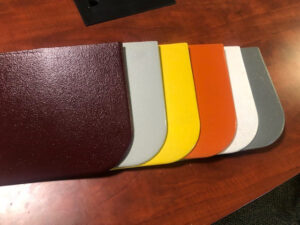Vibrant, Long-lasting Color For Recycled Rubber
Safepath’s processing technology delivers U-V stable, safe, aesthetically appealing color material
Rubber molded products derived from waste tires have long posed a challenge for colorization due to the presence of paraffins and oils inherent in the tire manufacturing process. Timothy Vanderheiden, CEO of Safe Path, sheds light on this issue, drawing from over a decade of research in rubber colorization products and processes. “Achieving desired color outcomes has been consistently elusive, despite attempts with iron oxide, colored urethanes, or EPDM materials,” Vanderheiden acknowledges.
In response to this challenge, Safe Path recently patented a groundbreaking process promising exceptional consistency in colorization across various materials. This innovation boasts high UV protection, wear resistance, and remarkable elongation properties, addressing critical durability concerns. “After rigorous three-year testing, we’re thrilled with the results,” Vanderheiden said “Our process mitigates the risk of delamination, crucial for applications in freeze-thaw environments.”
The significance of vibrant, long-lasting, UV-stable products crafted from recycled tire material cannot be overstated. Existing colorization processes often fall short in terms of longevity and consistency, making Safe Path’s breakthrough a game-changer in the marketplace. Moreover, it effectively encapsulates existing materials within the recycled tire product, preventing off-gassing and ensuring the production of safe, enduring products.
Safe Path’s specialized application equipment enables a multi-part manufacturing process, delivering consistent results unparalleled by single-step methods. Despite the thinness of the colorant coating—ranging from 0.5mm to 0.10mm—the results from Taber abrasion testing surpass those of all similar products in the market, enhancing its appeal for architectural applications.
 An unintended positive outcome of this technology is the incorporation of a long-lasting visual cue in recycled tire rubber molded products, enhancing both safety and aesthetic appeal. Various color enhancements broaden the scope of applications, from wall systems to traffic warnings, demonstrating the versatility of recycled tire material.
An unintended positive outcome of this technology is the incorporation of a long-lasting visual cue in recycled tire rubber molded products, enhancing both safety and aesthetic appeal. Various color enhancements broaden the scope of applications, from wall systems to traffic warnings, demonstrating the versatility of recycled tire material.
Encapsulating molded rubber products finds application in sensitive environments, such as clean rooms, utilizing a no-VOC, water-based material. Safe Path’s introduction of a textured surface further enhances safety, achieving a high SCOF rating for pedestrian use.
Overcoming challenges such as elongation and delamination during development underscores Safe Path’s dedication to rigorous testing and commitment to durability. Extended UV exposure testing confirmed the absence of cracking and delamination, affirming the technology’s resilience, Vanderheiden said.
In addition to its technical merits, Safe Path’s innovation holds significant environmental implications. By providing a viable and desirable solution for recycling waste tire material, the company contributes to reducing the environmental footprint of tire disposal. This aligns with global efforts towards sustainability and circular economy principles.
Furthermore, the introduction of Safe Path’s technology opens up opportunities for job creation and economic growth in the recycling and manufacturing sectors. As demand for recycled tire products increases, so does the need for skilled labor and production facilities, stimulating local economies and fostering innovation in green technologies.
Looking ahead, Safe Path remains committed to advancing its technology and expanding its market reach. Collaboration with industry partners, ongoing research and development, and investment in sustainable practices will drive continued success and impact in the recycling landscape.
“We’re excited to introduce a new generation of products meeting the architectural marketplace’s stringent demands,” Vanderheiden concludes. Safe Path’s breakthrough paves the way for previously untapped possibilities, making recycled tire material highly desirable across a wide range of applications.”
© Scrap Tire News, May 2024






